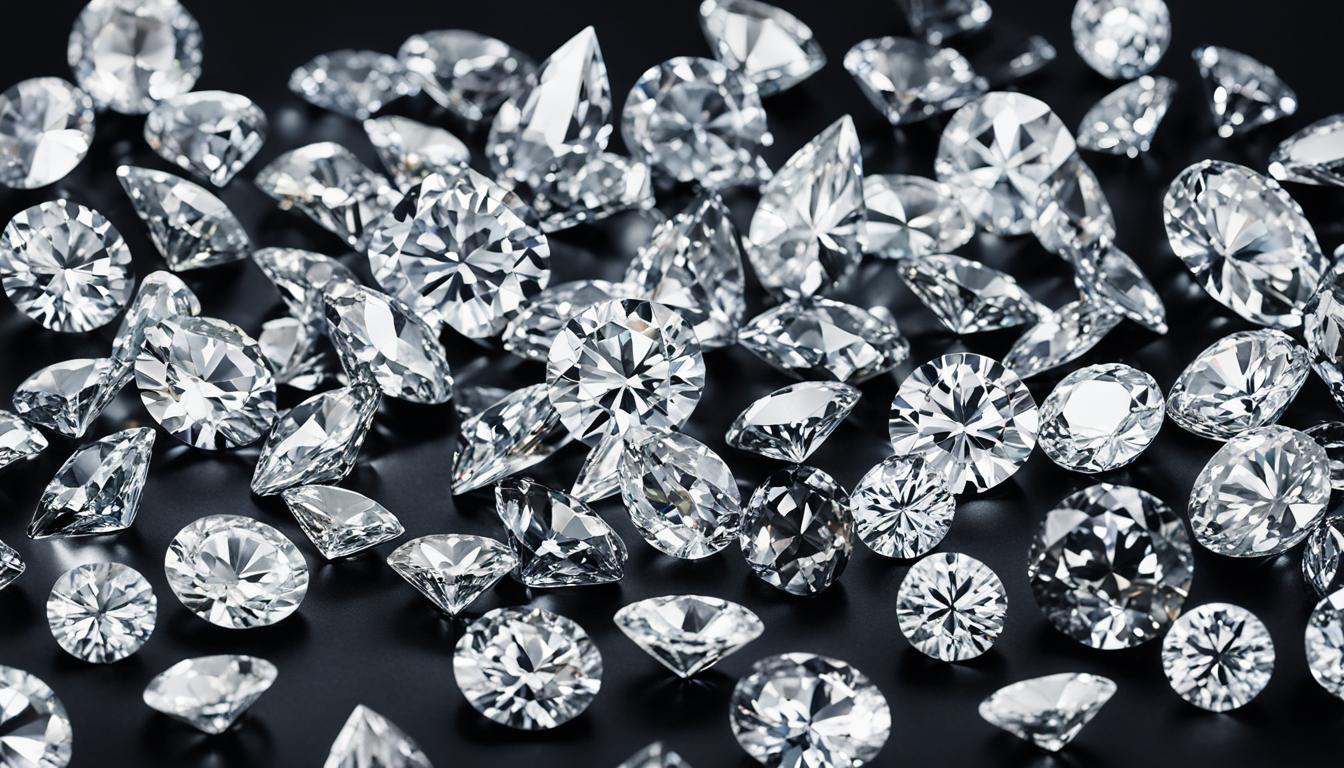I have always been fascinated by the mesmerizing sparkle and beauty of diamonds. The way they catch the light and create a dazzling display is truly enchanting. But did you know that not all diamonds are the same? There are various types of diamonds used in jewelry, each with its own unique characteristics and allure.
When it comes to diamond jewelry, it’s essential to understand the different types available to make an informed choice. From genuine diamonds to lab-grown alternatives and synthetic simulants, the options are diverse. Let’s take a closer look at each diamond type to better appreciate their individual qualities.
The Importance of Diamond Cut in Sparkle and Brilliance
The cut of a diamond plays a crucial role in enhancing its sparkle and brilliance. Different cuts and shapes create distinct patterns of light reflection, making each diamond unique in its visual appeal.
Popular diamond cuts for jewelry include the round brilliant and princess cut. These cuts are known for their faceting technique, which maximizes light performance by creating numerous angled surfaces for light to enter and exit the diamond. The result is a breathtaking display of sparkle and brilliance that captivates the eye.
While brilliant cuts are widely sought after, there is another category of diamond cuts that offers a unique and elegant alternative. Step-cut diamonds, such as emerald, asscher, baguette, and carré, have a different faceting style that creates a mesmerizing appearance.
Step-cut diamonds feature rectangular or square facets arranged in a step-like pattern, giving them a distinctive look. These faceting patterns highlight the diamond’s clarity and create larger, more open facets, allowing for a different play of light.
The shape of a diamond also plays a significant role in its visual impact. Round diamonds are classic and timeless, while square or rectangular diamonds, like emerald and Asscher cuts, exude sophistication and elegance.
When choosing a diamond for jewelry, considering the cut and shape is essential. Whether you prefer the brilliance of a round brilliant cut or the unique allure of a step-cut diamond, the right cut and shape can elevate the beauty and overall appeal of your jewelry piece.
With the right diamond cut, you can create a stunning piece of jewelry that reflects your personal style and captures the attention of those around you. The choice between brilliant cuts and step-cut diamonds ultimately depends on your preferences and the aesthetic you wish to achieve.
Next, let’s explore the impact of diamond color on its appearance in Section 3.
Understanding Diamond Color and its Impact on Appearance
The color of a diamond is a critical factor that greatly influences its overall appearance. Diamonds are graded on a color scale that ranges from D to Z. A diamond with a grade of D is considered colorless, while a diamond with a grade of Z exhibits a light yellow or brown hue.
Colorless diamonds are highly sought after due to their ability to reflect light with minimal interference, resulting in exceptional sparkle and brilliance. These diamonds are a popular choice for those seeking a timeless and classic look.
However, diamonds with faint hues can also possess their own unique charm. Some individuals appreciate the warmth and character that diamonds with subtle colors bring to their jewelry. These diamonds add a touch of personality and individuality to any piece.
Ultimately, the choice of diamond color is a matter of personal preference. Whether you prefer the pristine beauty of a colorless diamond or the warmth of a diamond with faint hues, both options can create stunning and captivating jewelry.
It’s essential to consider your own tastes and the desired aesthetic when selecting a diamond color for your jewelry. Whether you opt for a colorless diamond or one with a faint hue, make sure it aligns with your style and brings you joy.
For a better understanding of diamond colors, refer to the table below:
| Diamond Color Grade | Description |
|---|---|
| D | Colorless |
| E | Colorless |
| F | Colorless |
| G | Near Colorless |
| H | Near Colorless |
| I | Near Colorless |
| J | Near Colorless |
| K | Faint Yellow |
| L | Faint Yellow |
| M | Faint Yellow |
| N-Z | Light Yellow to Light Brown |
Understanding the beauty and characteristics of different diamond colors will help you make an informed decision when choosing the perfect diamond for your jewelry.
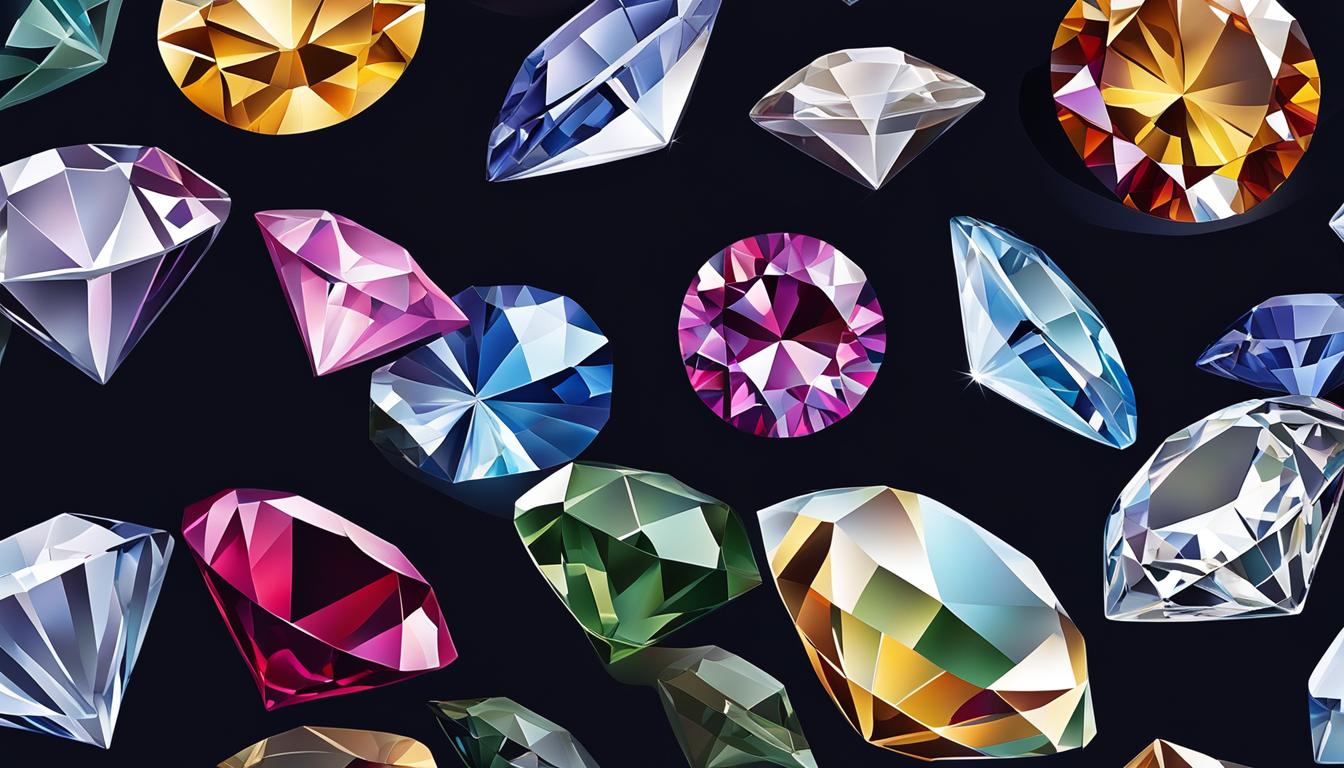
Exploring Diamond Clarity and Its Significance
Diamond clarity is an important factor to consider when purchasing jewelry. It refers to the presence of internal and external imperfections, known as inclusions and blemishes, respectively. These imperfections can affect the overall appearance of a diamond and its value.
The clarity of a diamond is graded on a scale that ranges from Flawless (no visible inclusions or blemishes) to Included (visible inclusions and/or blemishes). Each clarity grade represents a different level of imperfection, with Flawless diamonds being the rarest and most valuable.
Some individuals prefer diamonds with higher clarity grades because of their purity and pristine appearance. These diamonds are highly sought after for their brilliance and ability to reflect light without any interference. On the other hand, others appreciate the unique characteristics of diamonds with slight imperfections. These diamonds can have a charm of their own, showcasing nature’s fingerprints and adding character to the stone.
When choosing a diamond, it’s important to consider your personal preferences and budget. Higher clarity grades often come at a higher price point, while diamonds with lower clarity grades may offer a more affordable option without compromising beauty. Ultimately, the choice between a higher clarity grade or a diamond with slight imperfections depends on individual taste and the desired aesthetic.
“Diamond clarity is like a fingerprint – it adds personality to the stone and makes it truly one-of-a-kind.” – Diamond enthusiast
The Importance of Diamond Clarity Grades
Diamond clarity grades provide a standardized way to assess and communicate a diamond’s internal and external characteristics. They help jewelry buyers make informed decisions and understand the value of the diamond they are purchasing.
Understanding diamond clarity grades can also assist in evaluating the rarity of the stone. Diamonds with higher clarity grades, such as Flawless or Internally Flawless, are exceptional and represent a small percentage of the overall diamond market. These diamonds are highly valuable and sought after by collectors and diamond enthusiasts.
On the other end of the spectrum, diamonds with lower clarity grades, such as Included, may have visible inclusions or blemishes. While they may not have the same level of rarity or value as higher clarity grades, they can still be stunning and unique in their own right.
| Clarity Grade | Description |
|---|---|
| Flawless (FL) | No visible inclusions or blemishes at 10x magnification |
| Internally Flawless (IF) | No visible inclusions at 10x magnification, only minor blemishes on the surface |
| VVS1 (Very Very Slightly Included 1) | Very difficult to see inclusions at 10x magnification |
| VVS2 (Very Very Slightly Included 2) | Very difficult to see inclusions at 10x magnification |
| VS1 (Very Slightly Included 1) | Minor inclusions visible under 10x magnification |
| VS2 (Very Slightly Included 2) | Minor inclusions visible under 10x magnification |
| SI1 (Slightly Included 1) | Inclusions visible under 10x magnification |
| SI2 (Slightly Included 2) | Inclusions visible under 10x magnification |
| I1 (Included 1) | Inclusions visible to the naked eye |
| I2 (Included 2) | Inclusions visible to the naked eye |
| I3 (Included 3) | Inclusions visible to the naked eye |
Choosing the Right Diamond Clarity
When deciding on the ideal diamond clarity for your jewelry, it’s essential to consider various factors, including the size of the diamond, the setting style, and your personal preferences.
If you’re selecting a larger diamond or opting for a minimalist setting that showcases the stone’s clarity, you might prefer a higher clarity grade to ensure the diamond appears clean and free from visible imperfections. On the other hand, if you’re choosing a smaller diamond or a setting that includes accent stones, a slightly lower clarity grade might be more budget-friendly, as any imperfections may be less noticeable.
Ultimately, the perfect diamond clarity for your jewelry is subjective and depends on your unique style and budget. It’s always recommended to view diamonds in person and consult with a trusted jeweler, who can guide you in finding the ideal balance between clarity, beauty, and value.
The Role of Carat Weight in Diamond Value
When it comes to diamonds, carat weight plays a significant role in determining their value. Carat is the unit of weight used to measure diamonds, and larger diamonds generally have higher carat weights. However, it’s important to note that carat weight is not the sole determinant of a diamond’s quality and value.
While carat weight is often associated with diamond size, it’s crucial to understand that the impact of carat weight goes beyond mere dimensions. The weight of a diamond affects the way light interacts with it, ultimately influencing its brilliance and sparkle. Diamonds with a higher carat weight may exhibit a more pronounced and captivating play of light, making them visually stunning.
However, it’s essential to find a balance between carat weight and other factors such as cut and clarity. A diamond’s cut determines how effectively it can reflect and refract light, while clarity refers to the presence of internal and external imperfections. By considering all these factors together, you can create a beautiful and valuable diamond that combines size with exceptional brilliance.
While larger diamonds with higher carat weights may hold a certain allure, it’s important to remember that the overall beauty and value of a diamond depend on a combination of factors. A smaller diamond with excellent cut and clarity can outshine a larger diamond with poor cut and clarity. Therefore, it’s crucial to evaluate the overall quality and craftsmanship of a diamond, not solely relying on its carat weight.
“A diamond’s carat weight is like its size on the scale, but it’s the other factors that contribute to its actual value and appeal.”
To gain a better understanding of the relationship between carat weight and diamond value, refer to the table below:
| Diamond Carat Weight | Average Price Range |
|---|---|
| 0.25 – 0.49 carats | $500 – $2,000 |
| 0.50 – 0.99 carats | $2,000 – $10,000 |
| 1.00 – 1.49 carats | $10,000 – $30,000 |
| 1.50 – 1.99 carats | $30,000 – $50,000 |
| 2.00 – 2.99 carats | $50,000 – $100,000 |
As seen in the table, the price of a diamond increases as the carat weight rises. However, it’s important to note that the price range provided is an average estimate and can vary depending on other factors like cut, color, and clarity.
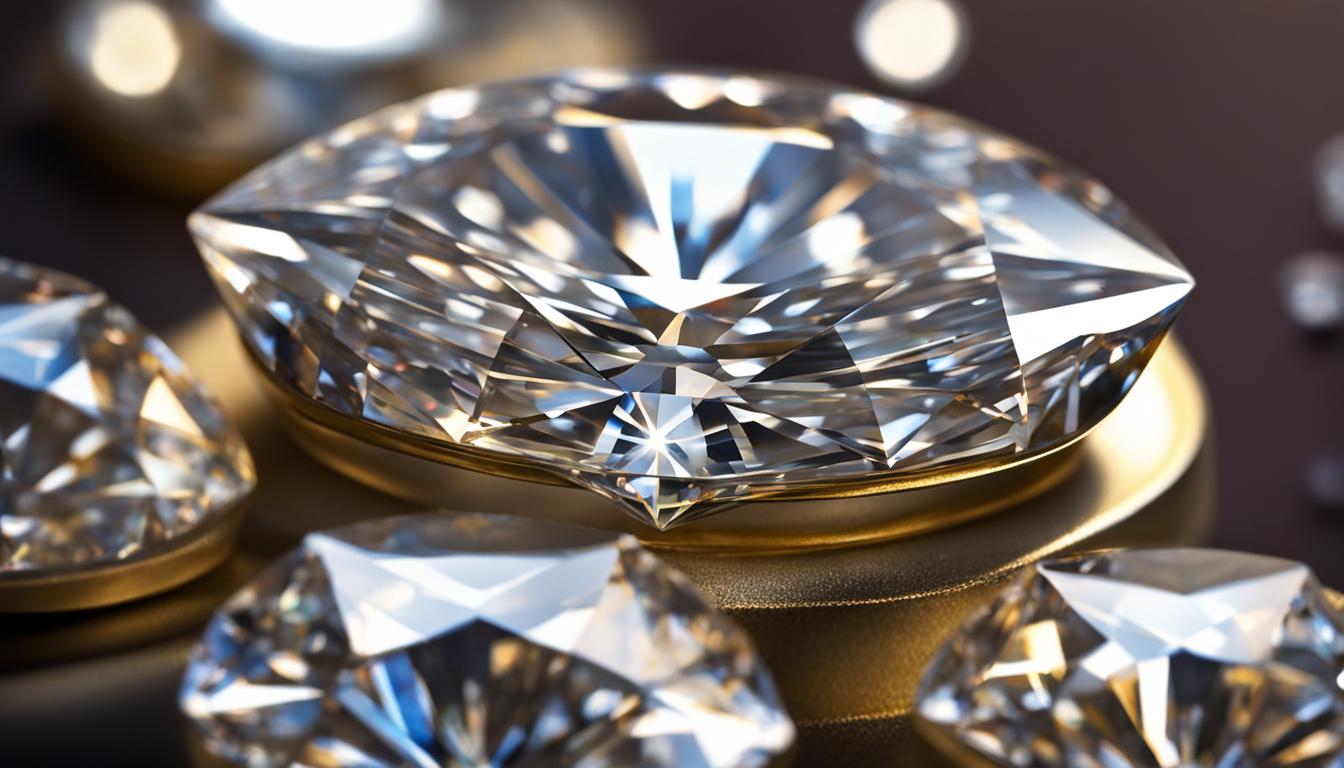
The Different Cuts and Shapes of Step-Cut Diamonds
When it comes to diamond cuts for jewelry, step-cut diamonds offer a unique and sophisticated option. These diamonds are characterized by their faceting style, which features rectangular or square facets that resemble steps. The step-cut diamonds include popular shapes like emerald, asscher, baguette, and carré, each with its own distinct characteristics and visual appeal.
Emerald diamonds, with their long and rectangular facets, create a stunning “hall of mirrors” effect. The elongated shape of emerald diamonds adds an elegant touch to any piece of jewelry.
Asscher diamonds, on the other hand, have X-shaped facets that create a mesmerizing sparkle. The unique faceting pattern of Asscher diamonds enhances their brilliance and gives them a captivating allure.
Baguette diamonds, known for their sharp and pronounced edges, offer a sleek and modern look. These diamonds are often used as side stones in engagement rings and are ideal for those who appreciate clean lines and minimalistic designs.
Carré diamonds, which resemble a pyramid from above, exude timeless beauty and elegance. The square shape of carré diamonds adds a touch of sophistication to any jewelry piece and is often favored by those who appreciate classic styles.
Whether you prefer the elongated and reflective beauty of emerald diamonds, the mesmerizing sparkle of Asscher diamonds, or the sleek and modern look of baguette or carré diamonds, step-cut diamonds offer a variety of options that can suit any style and preference.
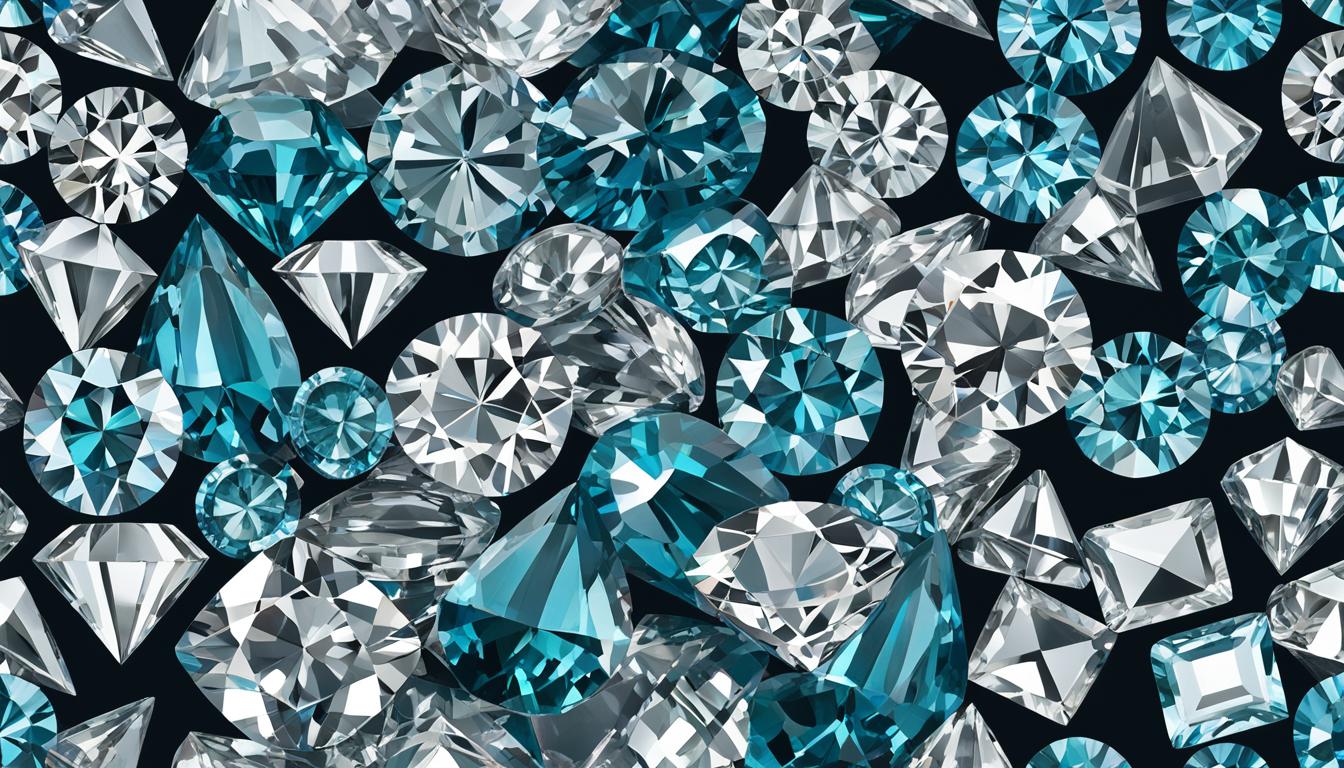
Key Takeaways:
- Step-cut diamonds have rectangular or square facets that resemble steps.
- Shapes like emerald, asscher, baguette, and carré are common for step-cut diamonds.
- Emerald diamonds have long, rectangular facets that create a unique “hall of mirrors” effect.
- Asscher diamonds have X-shaped facets that enhance their sparkle and allure.
- Baguette diamonds feature sharp and pronounced edges, perfect for modern designs.
- Carré diamonds resemble a pyramid from above, offering timeless elegance.
The Benefits and Concerns of Step-Cut Diamonds
Step-cut diamonds offer a sleek and elegant look, making them a popular choice among fans of vintage jewelry and those who appreciate minimalistic fashion. The clean lines and geometric shapes of step-cut diamonds create a timeless and sophisticated appeal.
One of the significant benefits of step-cut diamonds is their relatively lower cost compared to brilliant cuts. This is because step-cut diamonds retain more of the rough diamond’s carat weight during the cutting process. As a result, you can enjoy a larger diamond for your budget.
However, it’s important to consider that step-cut diamonds may have less sparkle than brilliant cuts. The faceting style of step cuts, with their rectangular or square facets, can produce fewer reflections and a more subdued brilliance.
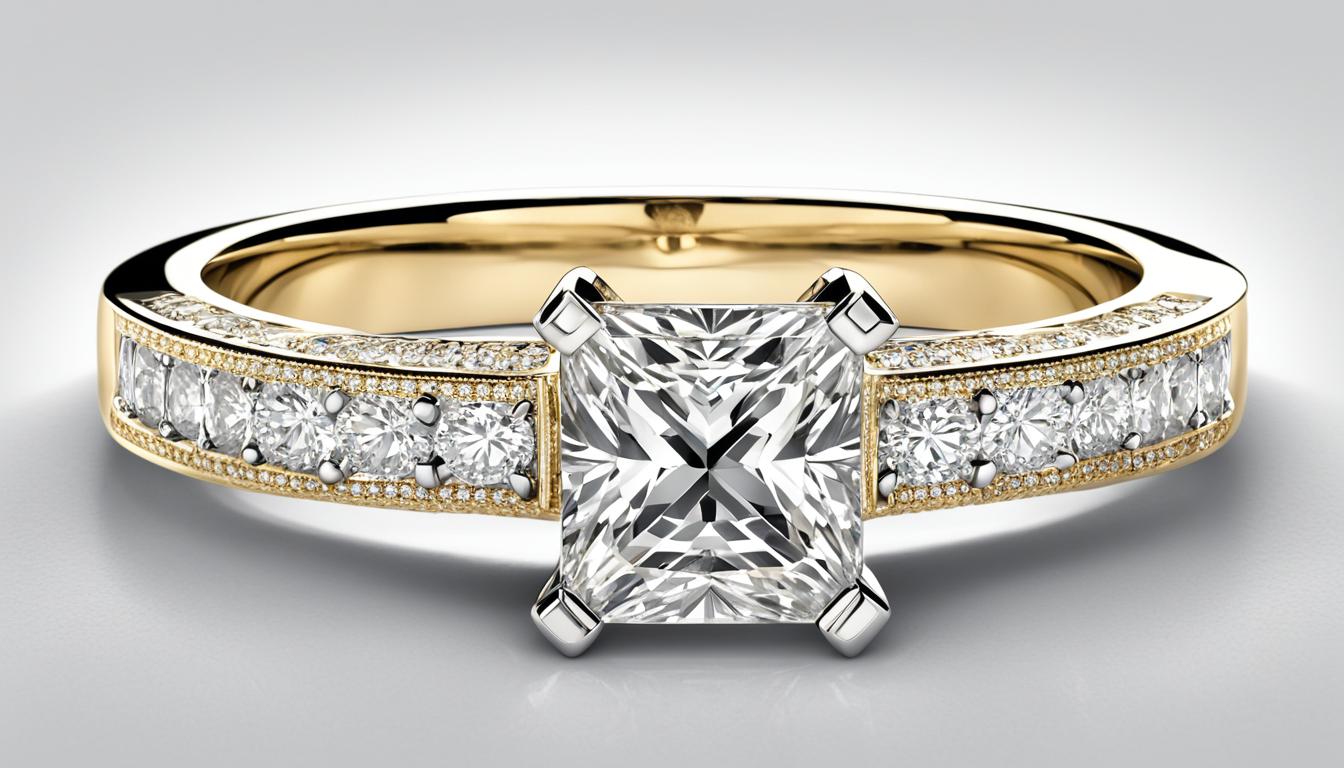
Additionally, the step-cut faceting style can potentially make any natural inclusions within the diamond more visible. Inclusions are internal characteristics that occur naturally in diamonds and are typically seen as small imperfections. While some may appreciate the unique character and story that inclusions can bring to a diamond, others may prefer stones with fewer visible imperfections.
Ultimately, the choice between step-cut diamonds and other diamond cuts for jewelry depends on personal preferences, style, and budget. Step-cut diamonds offer a distinct and elegant aesthetic, and their affordability and larger size can be appealing. However, it’s essential to consider the trade-offs in terms of sparkle and the potential visibility of inclusions.
The Importance of Clarity in Step-Cut Diamonds
When it comes to step-cut diamonds, clarity plays a crucial role in their overall appearance. The distinct faceting style of step-cut diamonds, such as emerald, asscher, baguette, and carré, can make any inclusions more visible. That’s why buyers should prioritize clarity and choose diamonds with fewer visible imperfections.
Having a good understanding of diamond clarity is essential when selecting a step-cut diamond for your jewelry. Clarity refers to the presence of internal and external imperfections, known as inclusions and blemishes. It is graded on a scale that ranges from Flawless, which indicates no visible imperfections, to Included, which signifies noticeable inclusions or blemishes.
To ensure the best quality and beauty of your step-cut diamond, it is important to find a balance between clarity and personal preferences. While some individuals appreciate the unique characteristics of diamonds with slight imperfections, others may prefer diamonds with higher clarity grades, which have fewer visible flaws.
High clarity step-cut diamonds tend to showcase exceptional transparency and allow light to pass through with minimal interruption, resulting in a clearer, more radiant appearance.
However, it’s crucial to remember that selecting a step-cut diamond with higher clarity may come at a higher price point. The rarity of step-cut diamonds with excellent clarity contributes to their value and cost. Therefore, it is essential to consider your desired aesthetic and budget when choosing a step-cut diamond that aligns with your preferences.
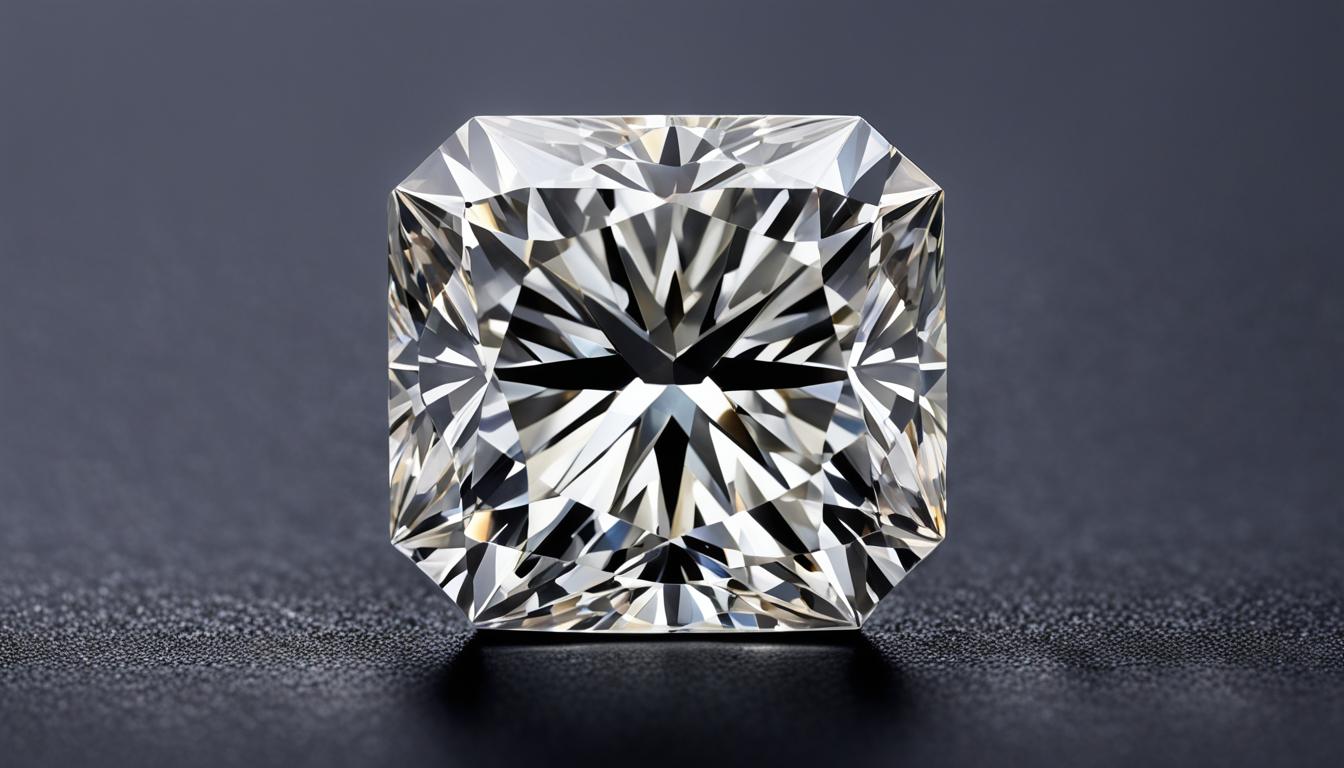
Comparing the Cost of Step-Cut Diamonds
When it comes to evaluating the cost of diamonds, the cut plays a significant role. Step-cut diamonds, including popular choices like emerald and Asscher cuts, often offer a more affordable option compared to brilliant cuts such as round and princess cuts. However, it’s important to note that the cost of a diamond is not solely determined by its cut; other factors like carat weight, color, and clarity also influence the final price.
Let’s take a closer look at the cost comparison of step-cut diamonds:
Please note that the cost range mentioned here is a general estimate and may vary based on various factors, including the specific diamond’s quality, the seller, and market conditions.
While step-cut diamonds like emerald and Asscher cuts typically fall into a more affordable price range, baguette and carré cuts can be slightly higher in cost. However, it’s essential to consider that a diamond’s overall price is a combination of multiple factors, including cut, color, clarity, and carat weight. It’s always recommended to prioritize personal style preferences and budget constraints when comparing the cost of step-cut diamonds.
Remember, diamond shopping is an exciting journey, and finding the perfect diamond within your desired price range is possible with careful consideration and research.
Conclusion
The world of diamond jewelry offers a dazzling array of options, with different types of diamonds used in jewelry to suit every taste and budget. Whether you prefer the unique elegance of a step-cut diamond or the maximum sparkle of a brilliant-cut diamond, your choice ultimately depends on your personal preferences, style, and budget.
Step-cut diamonds, such as the emerald, asscher, baguette, and carré cuts, bring a distinctive charm to any jewelry piece. Their sleek and minimalistic faceting style appeals to those who appreciate vintage-inspired designs and a sophisticated aesthetic. On the other hand, brilliant cuts like the round brilliant and princess cuts mesmerize with their dazzling brilliance and ability to reflect light.
When selecting a diamond, it is essential to consider the 4Cs: cut, color, clarity, and carat weight. These factors determine the diamond’s appearance, value, and overall quality. Whether you prioritize a specific combination of these characteristics or seek a balance between them, understanding the 4Cs is crucial to making an informed choice.
Ultimately, the decision to invest in diamond jewelry goes beyond the technicalities. It is about finding a piece that resonates with you and brings joy. Diamonds are not only a symbol of love and beauty but also a timeless and cherished heirloom that can be passed down through generations. So, whether you prefer the elegance of a step-cut diamond or the brilliance of a brilliant-cut diamond, your diamond jewelry becomes a precious treasure, forever capturing the sparkle of your unique story.
FAQ
What are the different types of diamonds used in jewelry?
The different types of diamonds used in jewelry include genuine diamonds, lab-grown diamonds, and diamond simulants like cubic zirconia and moissanite.
What is the importance of a diamond cut in sparkle and brilliance?
The diamond cut determines the sparkle and brilliance of a diamond. Different cuts, such as round brilliant and princess cut, create maximum light performance, while step-cut diamonds like emerald and asscher have a unique faceting style.
How does diamond color impact the appearance of a diamond?
Diamond color is graded on a scale from D to Z, with D being colorless and Z being light yellow or brown. Colorless diamonds reflect light with minimal interference, while diamonds with faint hues offer warmth and character.
What is the significance of diamond clarity in jewelry?
Diamond clarity refers to the presence of inclusions and blemishes. Clarity is graded on a scale from Flawless to Included, which affects a diamond’s overall value and appearance.
How does carat weight affect the value of a diamond?
Carat weight is the unit of weight for diamonds and influences a diamond’s size, as well as how light interacts with it. Finding a balance between carat weight, cut, and clarity is important in selecting a valuable diamond.
What are step-cut diamonds, and what shapes do they come in?
Step-cut diamonds, including emerald, asscher, baguette, and carré, have a faceting style characterized by rectangular or square facets that resemble steps.
What are the benefits and concerns of step-cut diamonds?
Step-cut diamonds offer a sleek and elegant look, are popular for vintage jewelry, and cost less than brilliant cuts. However, they may have less sparkle and natural inclusions may be more visible due to the faceting style.
How important is clarity when considering step-cut diamonds?
Clarity is important in step-cut diamonds as the faceting style can make inclusions more visible. Balancing clarity and personal preferences ensures a step-cut diamond meets the desired aesthetics and budget.
How do the costs of step-cut diamonds compare to other cuts?
Step-cut diamonds like emerald and asscher tend to be more affordable than brilliant cuts like round and princess. Baguette and carré cuts fall in the middle. However, the overall cost is determined by factors beyond cut, such as carat weight, color, and clarity.
How do I choose between step-cut diamonds and brilliant-cut diamonds?
The choice between step-cut and brilliant-cut diamonds depends on personal preferences, style, and budget. Consider the 4Cs (cut, color, clarity, and carat weight) to ensure a diamond meets aesthetic and value requirements.

